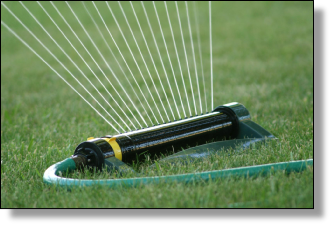Lawn Watering Tips
Looking for some ways to save water and money? Try these helpful lawn watering tips.

- Delay regular lawn watering during the first cool weeks of spring. This encourages deeper rooting and makes your lawn healthier for the rest of the summer. It also delays the first time you have to mow.
- Water any small grass areas by hand to avoid waste. On steep slopes, try a soaker hose to help prevent wasteful runoff.
- Sprinklers that throw large drops in a flat pattern are much more effective than those with a fine, high spray. You will lose less water to evaporation with the larger drops.
- Water in the morning before it gets too hot. Your lawn will absorb more moisture.
- Make sure you water the grass only. Watering your sidewalk or driveway is money down the drain.
- Don’t water on windy days. You’ll lose water to evaporation and your water may not go where you want it to go.
- Step on the grass — if it springs back you don’t need to water; if it stays flat or leaves footprints — it’s time to pull out the hoses.
- Use short on/off sprinkler cycles (about 5-15 minutes on, 1 hour off, then repeat until well watered).
Lawn Watering Guide
Here’s a simple way to determine your lawn’s watering needs:

- Place five or more flat bottom cans or coffee mugs randomly around your lawn.
- Turn on your sprinkler(s) for 15 minutes.
- Measure the depth of the water in each can with a ruler to determine the average water depth in the cans.
- Refer to the chart below and read the number of minutes you should water every third day. Record the times for future references.
Reminder: Use this chart as a guide only, and alter your water practices according to climatic conditions.

Decrease watering times and frequencies during cool and/or humid weather. Skip at least one scheduled watering after any substantial rainfall. Not all soil is the same. If your grass grows on mostly clay soil, between 1/4- and 1/2-half inch of water per hour can be absorbed before it starts running off wastefully. If you have sandy soil, you’ll need to water more often and for shorter periods of time.
Xeriscaping: 7 Steps to a Water Wise Yard
Xeriscaping (pronounced zír uh scaping) is a method of landscaping based on common sense that can save 30-60% of your water use. By growing plants that thrive in our specific region and climate, your yard will be easy to maintain so you will save money, time and water. You can be creative as well as efficient with xeriscaping.

Oregon State University Extension Service has come up with a great web guide to Xeriscaping in Central Oregon (click the graphic to open)
Your yard can be as lush and colorful as a traditional yard by following these seven steps
- Plan ahead: Planning is the key to successful landscaping. Consider: function, appearance, maintenance and budget. Your local nursery, extension service, or landscaper can help.
- Limit Lawn Areas: Turf requires the most water and maintenance. Locate lawn space where it will be most functional. Decks or patios are a replacement option. Contemplate using grasses more suited to your area. It will use less water and be easier to maintain.
- Choose plants with a low water demand: Use water-thrifty groundcovers, grasses, trees, and shrubs that are well adapted to your region. They will require less care and will thrive in your soil and climate. Group like water users together. You will be able to give the proper care to each grouping.
- Prepare soil thoroughly: Turn and loosen soil at least 6” down and remove all rocks. Add organic material (such as peat or mint slugs) to flower and shrub beds. This will increase the soil’s ability to absorb and store water.
- Use mulch: Adding 2”- 6” of mulch around plants helps conserve water and keeps weeds from growing.
- Use an efficient irrigation system: Consult your local nursery or hardware store about purchasing sprinklers or drip irrigation.
- Maintain your landscape properly: This includes watering, weeding, fertilizing, pruning, and pest control.
For additional ideas on using Xeriscaping for your landscaping, check out HGTV’s design website here. (No affiliation with DVWD)
Front Loading Washers

Are you in the market for a new clothes washer? Before you buy, consider all of your options. While the initial cost may be greater, a front loading washer saves money in ways the traditional top loading washer does not.
First, it uses about a third of the amount of water the top loading washer does. That saves on your water bill and if you are washing with hot or warm water it will save on your water heating bill additionally.
Second, your detergent costs will go down as well. The front loading washers use only a fraction of the detergent the traditional washer uses.
Thirdly, your clothes are cleaner and there is less wear and tear on them. The top loading washer uses an agitation motion to clean your clothes which is hard on them.
Many people are placing their washers and dryers on a platform so there is no bending over to load and unload their machines. Less bending over means less wear and tear on you too.
FYI – Just remember that the seals on the doors of front loading washers are made to seal very tight and if you close the door after your washing is done, and there is still even the slightest bit of moisture inside, mildew odors will develop. Try to leave the door open or at least cracked between loads.
Tax credits for purchases of energy efficient appliances may also be available. For more information go to: https://energytrust.org/residential/incentives/Appliances/
